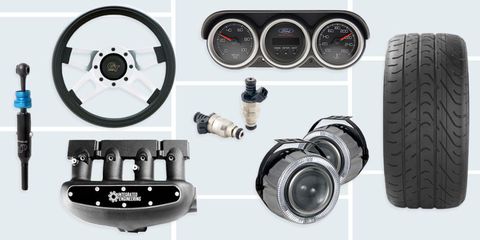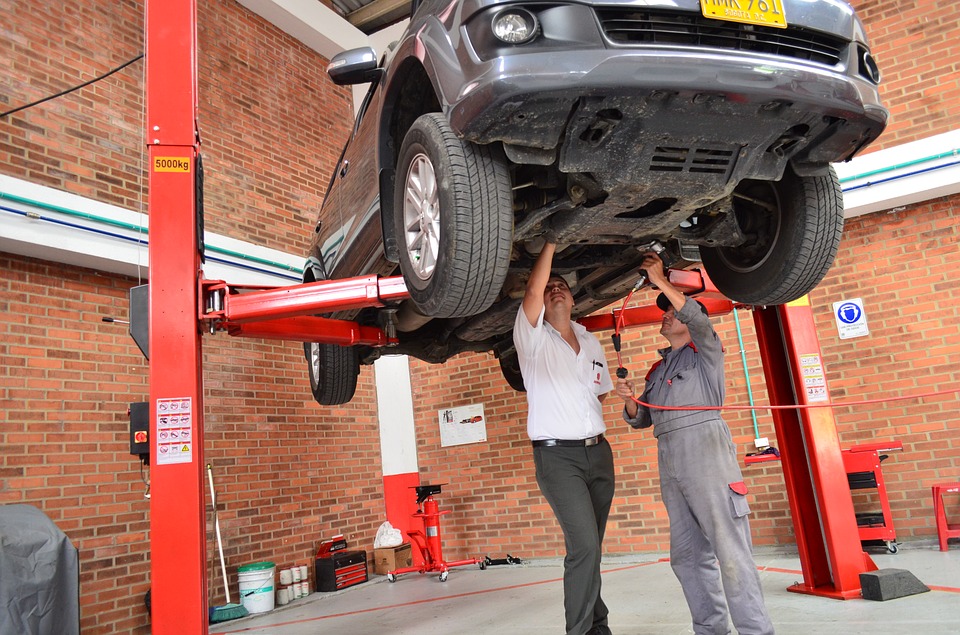Do You Need to Use the Car in Spanish
It's official. You are going to Mexico on vacation!
Or maybe you have found your dream job and are moving to Argentina.
Oh, I know; you are attending a conference in Puerto Rico, aren't you?
Whatever the reason, it all comes down to one thing—you are visiting a Spanish-speaking country, and you need some Spanish car vocabulary in case you have any problems while abroad.
Download: This blog post is available as a convenient and portable PDF that you can take anywhere. Click here to get a copy. (Download)

Why Learn Car Parts in Spanish Vocabulary? How Will This Help Me?
I am assuming you are going to travel to a Spanish-speaking country, but then again, maybe you are just learning Spanish from the comfort of your leather sofa, and you just want some vocabulary related to cars.
If that is the case, cool. You can learn the vocabulary included in this post and then move on with your life.
But maybe you are actually going to visit a Spanish-speaking country soon, and you plan on traveling by car, or renting a car when you arrive.
I do not want to jinx your trip, but what if something happens while on the road? What if the car stops working, or you have an accident?
That is when this post can really come in handy.
You are seconds away from learning how to say the main parts of a car in Spanish, but not only that!
In this post, you will also learn about the nuances and differences one can find when traveling to various Spanish-speaking countries. The best example of this is the fact that we have several different words to refer to a car in Spanish, and the word for car in Latin America can be a totally different thing in Spain.
This post will also help you to solve your main car problems while on the road. You will get tons of ready-made sentences and expressions you can use when you need to talk to a mechanic or call the tow truck.

Finally, you will find everything together in the form of two sample dialogues. The dialogues will obviously not cover every single problem and situation you can have with your car, but I will make sure that it looks like a real-life, organic dialogue, just like you will find on FluentU.
The program is completely customizable. You choose the videos you want to watch, and then you test your knowledge according to that.
FluentU includes the most awesome system of interactive subtitles for each of its videos. Just click on a word and get a floating flashcard showcasing all the necessary information about that word—translation, pronunciation and sample sentences included.
Give FluentU a free try before embarking on your next trip to a Spanish-speaking country. You will thank me later.
And now, back to cars!
Dude, Where's My Car Parts in Spanish?
On Cars in General

You have probably heard the word carro (car) before, especially if you have been learning any variety of Latin American Spanish. But if you find yourself in Spain, carro will not mean what you want it to mean.
See, when learning Spanish, you should become acquainted with different varieties of Spanish, not only one, much as I had to learn the differences between American, British, Canadian and Australian English during my studies.
The Spanish word (words, actually) for a car is a great example of this.
Let's have a look at them.
Auto
Auto is short for automóvil (automobile).
The word automóvil comes from Greek auto (self) and Latin mobilis (movable). Together, they form the word automóvil, which is a vehicle that moves by itself.
The word automóvil is very seldom used, and most people prefer the shorter version auto. However, auto is not commonly used throughout all Spanish-speaking countries.
According to my research, it is most often used to refer to a car in Argentina, Chile, Peru and Uruguay.
Carro
Carro comes from the Latin wordcarrus, which was used to refer to the ancient two-wheeled chariots drawn by horses.
This word is used in two different ways nowadays.
If you go to Spain, carro refers to either a horse-drawn buggy or a shopping trolley. In a way, the word has kept part of its original meaning.
But if you go to Latin America, especially to countries such as Colombia, Mexico or Venezuela, you will discover that they use the word carro to refer to a car.
Coche
Our last word is coche, which comes from Hungarian kocsi, a four-wheeled coach or wagon pulled by horses that started being used in the small Hungarian town of Kocs in order to transport people.
Despite being originally pulled by horses, its function seems to have been the one that made Spanish people start using the wordkocsi back in the 16th century. Fast-forward a couple of centuries, and you get the word coche, which is used in Spain and some parts of Argentina and Mexico to refer to a car.
Coche is also used in Chile to refer to the horse-drawn buggy.
Parts of a Car

It would be impossible to name all the parts of a car in one post.
I have selected the most important ones or rather, the ones I consider you may need to use in case of an emergency or car-related situation in a Spanish-speaking country.
el asiento (the seat)
Este asiento es muy cómodo. (This seat is very comfortable.)
el cinturón / el cinturón de seguridad (the seatbelt)
Abróchate el cinturón. (Fasten your seatbelt.)
la alfombrilla (the vehicle mat; literally the little carpet)
He tenido que comprar alfombrillas nuevas para mi coche. (I have had to buy new mats for my car.)
el volante (the steering wheel)
Coloque las manos en el volante. (Place your hands on the steering wheel.)
el acelerador (the gas pedal)
Su coche hacía un ruido extraño cada vez que pisaba el acelerador. (His car made a strange noise every time he put his foot on the gas pedal.)
el freno (the brake)
¿Cuál es el pedal del freno? (Which one is the pedal for the brake?)
el freno de mano (the handbrake / the parking brake)
Tire de la palanca hacia arriba para activar el freno de mano. (Pull the level up to apply the handbrake.)
la luz de freno (the brake light / the stop light)
La luz de freno se activa cuando se pisa el pedal de freno. (The brake light is activated when the brake pedal is pushed.)
el embrague (the clutch)
El embrague de mi auto está dañado. (The clutch in my car is damaged.)
la guantera (the glove compartment)
Los documentos están en la guantera. (The documents are in the glove compartment.)
la caja de cambios (the gearbox / the transmission)
La caja de cambios está colocada sobre tacos de goma. (The transmission is mounted on rubber pads.)
la marcha (the gear)
No sé cómo cambiar de marcha. (I do not know how to change gear.)
el claxon / la bocina (the horn)
María tocó el claxon tres veces. (María sounded the horn three times.)
el conductor / el chófer (the driver)
El conductor del vehículo falleció en el accidente. (The driver died in the accident.)
el parabrisas (the windshield)
El parabrisas se rompió en pedazos. (The windshield shattered into pieces.)
el limpiaparabrisas (the windshield wiper)
Necesito cambiar los limpiaparabrisas. (I need to have the windshield wipers replaced.)
la visera (the sunshield)
Baja la visera, por favor. (Pull down the sunshield, please.)
la ventanilla del auto (the car window)
¿Puedo bajar la ventanilla? (Can I roll down the window?)
la llanta(AmL) / la rueda (ES) / el neumático (the tire)
¿Monta neumáticos nuevos? (Do you fit new tires?)
la rueda de repuesto (ES) / la rueda de auxilio (AR) / la rueda de refacción (MX) / la llanta de repuesto (the spare tire)
¿Tiene alguna llanta de repuesto? (Do you have any spare tire?)
el parachoques / el paragolpes (the bumper)
Este vehículo incluye sensores de aceleración en el parachoques. (This vehicle includes acceleration sensors in the bumper.)
las luces / los faros del coche (the car lights)
las luces / los faros delanteras/os (the front lights / the headlamps)
las luces / los faros traseras/os (the rear lights / the taillights)
Este carro posee tres luces traseras. (This car has three taillights.)
las luces / los faros antiniebla (the fog lamps / fog lights)
el capó (the hood)
El motor está bajo el capó. (The engine is under the hood.)
el maletero / la cajuela (MX) (the trunk)
Había un maleta rosa en el maletero. (There was a pink suitcase in the trunk.)
el motor (the engine)
El compresor está conectado al motor del coche. (The compressor is connected to the engine of the car.)
el tanque / depósito de combustible / gasolina (the gas tank)
Tenemos que llenar el tanque de gasolina antes de marcharnos. (We have to fill up the gas tank before we go.)
el salpicadero (the dashboard)
He olvidado el teléfono en el salpicadero del coche. (I have forgotten my phone on the dashboard.)
el tubo / caño de escape (the tailpipe)
Deberíamos controlar las emisiones del tubo de escape. (We should control the tailpipe emissions.)
la válvula (the valve)
¿Para qué sirven las válvulas en un carro? (What is the use of valves in a car?)
el cigüeñal (the crankshaft)
No logro localizar el sensor de posición del cigüeñal. (I cannot find the crankshaft position sensor.)
la suspensión (the suspension)
La suspensión del auto no funciona correctamente. (The car suspension does not work properly.)
la batería (the battery)
¿Cuánto se tarda en cargar la batería de un coche? (How long does it take to charge a car battery?)
la bomba de agua (the water pump)
El mecánico dice que el problema está en la bomba del agua. (The mechanic says the problem is in the water pump.)
la luz direccional / el intermitente (the turn signal / the blinker)
Oirá clics mientras el intermitente esté encendido. (You will hear clicks while the turn signal is on.)
el espejo retrovisor (the rear-view mirror)
Ajusta tu retrovisor para tener una visibilidad máxima. (Adjust your rear-view mirror for maximum visibility.)
la bujía (the spark plug)
Deberías limpiar las bujías. (You should clean the spark plugs.)
Solving Your Car Problems

Mi carro ha tenido una avería . (My car has had a breakdown.)
El / La …no funciona . (The…is not working.)
Necesito… (I need…)
¿Hay alguien que pueda ayudarme, por favor? (Can anyone help me, please?)
¿Hay un taller de coches por aquí? (Is there any car workshop near here?)
¿Dónde está el taller de coches más cercano? (Where is the closest car workshop?)
Se me ha pinchado / vaciado una rueda . (I have a flat tire.)
Me he quedado sin gasolina. / Se me ha acabado la gasolina. (I have run out of gas.)
El coche no arranca. (ES) / El carro no prende. (AmL) (The car will not start.)
La batería está muerta / vacía. (The battery is flat / dead / empty.)
Necesito una grúa. (I need a wrecker.)
El / La…hace un ruido extraño. (The…is making a strange noise.)
Sample Dialogues
1. At the car rental agency

Dependiente (Clerk): Buenos días, ¿en qué puedo ayudarle? (Good morning, may I help you?)
John Doe: Quisiera alquilar un auto. (I would like to rent a car.)
Dependiente: Fantástico. ¿Qué tipo de auto anda buscando? (Great. What kind of car are you looking for?)
John Doe: ¿Tienen compactos? (Do you have a compact?)
Dependiente: Por supuesto. La cuota es 60 dólares al día. Si desea seguro completo, serían 10 dólares adicionales. (But of course! The rate is 60 dollars per day. If you want full coverage insurance, that would be 10 more dollars.)
John Doe: ¿Hay límite de millaje? (Is there a mileage limit?)
Dependiente: No. Todos nuestros autos tienen millaje ilimitado. (No, there is not. All our cars have unlimited mileage.)
John Doe: Perfecto. Entonces elijo el compacto azul. Lo necesitaré por tres días. (Perfect. Then I choose the blue compact. I will need it for three days.)
Dependiente: ¿Puedo ver su licencia para manejar? (May I see your driver's license?)
John Doe : Claro, no hay problema. Aquí tiene. (Sure, no problem. Here you are.)
Dependiente: Gracias. Por favor, rellene este formulario. (Thank you. Please, fill in this form.)
2. At the car workshop

Mecánico (Mechanic): ¿Cuál es el problema? (What seems to be the problem?)
Jan Doe: El carro está haciendo un ruido extraño. (The car is making a strange noise.)
Mecánico: ¿Ha podido localizar el ruido? (Have you been able to locate the noise?)
Jan Doe: Parece que viene del motor, pero no estoy seguro. (It seems to come from the engine, but I am not sure.)
Mecánico : Echémosle un vistazo. ¿Puede prender el carro y abrir el capó, por favor? (Let's have a look. Could you please start the engine and pop the hood?)
Jan Doe: Sí, claro. Enseguida. (Sure, right away.)
Mecánico: Hmm… No se oye ningún ruido. ¿Está seguro de que viene del motor? (Hmm…I cannot hear anything. Are you sure it was coming from the engine?)
Jan Doe: Estoy bastante seguro. Cuanto más rápido manejaba, más fuerte era el ruido. (Pretty sure. The faster I was driving, the louder the noise was.)
Mecánico: Entiendo. Parece que el carburador está mal ajustado. (I see. It seems that the carburetor is not adjusted correctly.)
Jan Doe: ¿Eso es todo? (Is that all?)
Mecánico: Veo que hay una fuga de líquido refrigerante. ¿Puedo echar un vistazo debajo del auto? (I see there is a coolant leak. Can I have a look under the car?)
Jan Doe: Sí, no hay problema. (Sure, no problem.)
Mecánico: ¡Bingo! He encontrado el problema. El mofle está suelto. (Bingo! I have found the problem. The muffler is loose.)
As you can see, sometimes you will have to bear in mind some words mean different things in different countries, but do not let this stress you. Native Spanish speakers are aware of the fact that there are different varieties of Spanish, and we normally understand each other well even if we have not been abroad.
Besides, as long as you know the basics, who cares if you call a car carro or coche? At the end of the day, you will be understood.
I hope the ready-made sentences and the sample dialogues help you to have a general idea of how a conversation with a clerk or a mechanic might go. Use them as a model to create your own sentences and dialogues, and include different parts of a car and different emergency situations.
By the time you arrive at your destination, you will be a real Spanish car master.
Download: This blog post is available as a convenient and portable PDF that you can take anywhere. Click here to get a copy. (Download)
If you liked this post, something tells me that you'll love FluentU, the best way to learn Spanish with real-world videos.
Experience Spanish immersion online!
Do You Need to Use the Car in Spanish
Source: https://www.fluentu.com/blog/spanish/car-parts-in-spanish/
0 Response to "Do You Need to Use the Car in Spanish"
Post a Comment